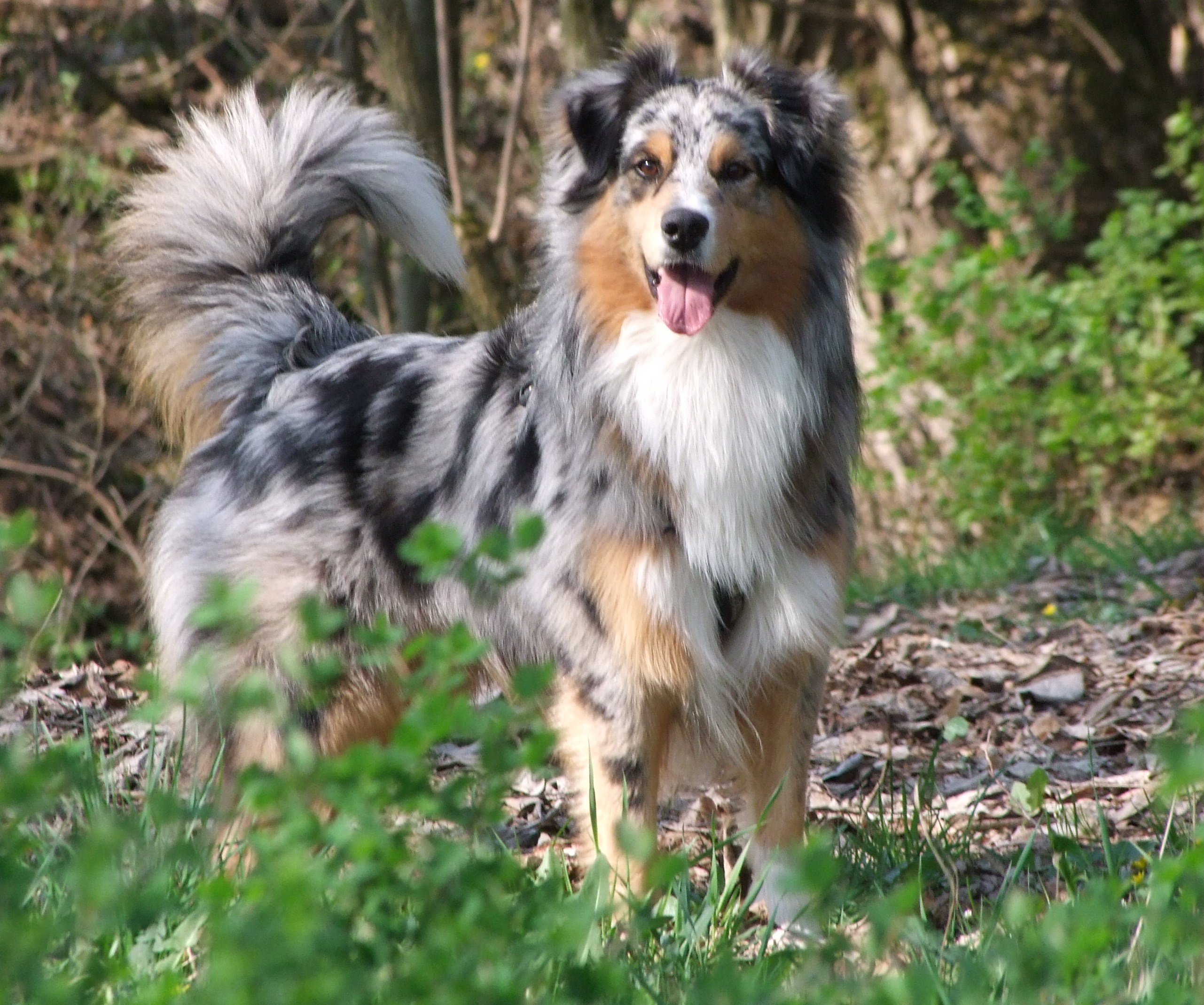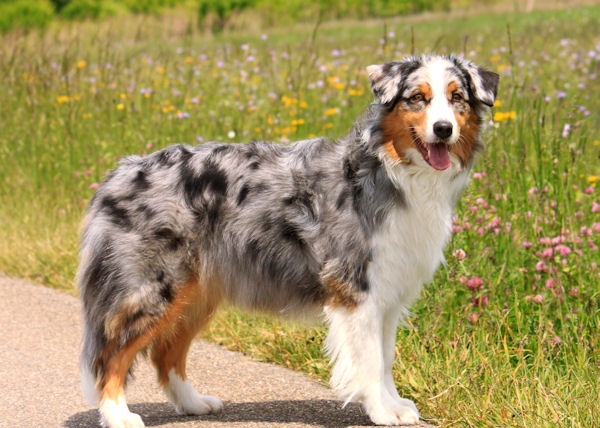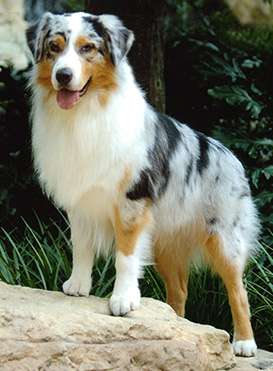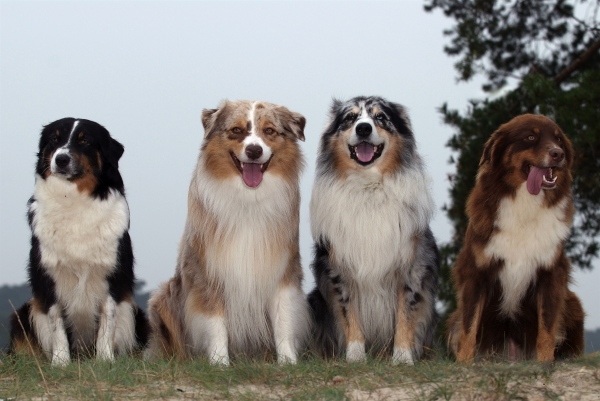
The Breed History
This cattle herding breed was primarily developed in California in
the 1900s, but their origins trace back to the immigration of Basque
shepherds. In Australia, there are similar dogs called German
Coolies, but the Australian Shepherd is considered a separate
breed, and was developed in the United States not Australia as
the name might imply. Collies and Australian Sheepdogs figure
most prominently in the ancestry of the Australian Shepherd. The
Australian Shepherd Club of America was established in 1957. First
AKC registry dates to 1991.
Breeding for Function
The breed excels at watching large herds. Their "eye" for scanning
the herd and reacting only when necessary gives them an edge
as the herder's aide. Their sensible herding judgment allows them
to manage a herd with a reasonable energy outlay, resulting in
the capacity to work long days. Because of their intelligence, their
trainability and personality makes them suited for guide dog work,
drug detection, for search and rescue missions and as companions.
Physical Characteristics
Height at Withers: female 18-21" (45.5-53 cm), male 20-23" (51-58.5 cm).
Weight: 35-70 lb (16-32 kg).
Coat: The coat is moderate in length and density, wavy or straight
and moderate feathering is present on the forelegs and britches;
a mane and frill are developed. Colors include red, red merle, blue
merle, and black. These may be combined with markings of specified
size and distribution including white and copper.
Longevity: 12-13 years
Points of Conformation: These dogs are medium in build and slightly
longer than tall. The tail is either naturally bobbed or is docked to
about 4" in length. A moderate stop divides the rounded muzzle
from skull. An alert expression emanates from almond shaped eyes.
Iris pigment is variable and can include brown, blue and amber. Ears
are triangular and moderate in size, and break in a fold hanging
forward or backwards. The nose is black for all but red or red merle
dogs, where a liver nose is evident. Neck is moderate in muscling. The
topline is level, ending in a moderately sloping croup. The thorax is
deep and the ribs well sprung, and abdomen is moderately tucked up.
The limbs are straight boned, feet compact and well knuckled up. Rear
dewclaws are always removed. Gait is agile, and appearing effortless.
Recognized Behavior Issues and Traits
Reported breed attributes include: Affinity for children, loyal,
strong guarding and herding instincts, very high intelligence and
sound temperament. They are active, tend to get along well with
other pets, have high trainability, are aloof with strangers and are
good alarm barkers. They are average shedders and best suited to
rural living or a home with a large fenced yard. They need mental
stimulation to prevent boredom vices. They like to be kept busy with
games and social contact.
Normal Physiologic Variations
Merle Coat Color: Caused by a dominant mutation in the SILV
gene. Breeding two merle dogs together should be avoided, as
homozygous dogs can be born with multiple defects, including
blindness, deafness, and heart anomalies.
Drug Sensitivities
MDR1/ABCB1 Mutation (Ivermectin/Drug Toxicity): Autosomal
recessive disorder in the MDR1/ABCB1 gene allows high CNS drug
levels of ivermectin, doramectin, loperamide, vincristine, moxidectin,
and other drugs. Causes neurological signs, including tremors,
seizures, and coma. A genetic test is available for the mutated
gene, showing 10.0% of Australian Shepherds are affected, and
36.9% are carriers. In Germany, 6.9% of Australian Shepherds test
homozygous affected, and 25.2% test as carriers.
Inherited Disease
Hip Dysplasia: Polygenically inherited trait causing degenerative
joint disease and hip arthritis. OFA reports 5.8% affected.
Elbow Dysplasia: Polygenically inherited trait causing elbow
arthritis. OFA reports 4.3% affected.
Legg-CalvР№-Perthes Disease: Polygenically inherited. Can be
unilateral or bilateral, with onset of degeneration usually under 9
months of age. Treat surgically if causing lameness or discomfort.
Australian Shepherds found to have a 191.4x odds ratio for
developing the disease versus other breeds.
Cataracts: A mutation in the HSF4 gene is associated with
co-dominant cataracts in the breed, although other inherited
cataracts also occur. Australian Shepherds homozygous for the
mutation tend to develop bilateral nuclear cataracts, and dogs with
one copy of the defective gene have a 17.7x risk of developing
posterior polar subcapsular cataracts. CERF reports anterior and
posterior cataracts are equally represented in the breed, and can be
intermediate or punctate. Reported in 2.43% of Australian Shepherds
CERF examined by veterinary ophthalmologists between 2000-2005.
CERF does not recommend breeding any Australian Shepherd with a
cataract. A direct genetic test for the HSF4 mutation is available.
Patella Luxation: Polygenically inherited laxity of patellar ligaments,
causing luxation, lameness, and later degenerative joint disease.
Treat surgically if causing clinical signs. OFA reports 1.9% affected.
Collie Eye Anomaly/Choroidal Hypoplasia/Coloboma (CEA/CH):
Autosomal recessive disorder of eye development that can lead
to retinal detachment and blindness. Iris coloboma is reported
in 1.45% of Australian Shepherds CERF examined by veterinary
ophthalmologists between 2000-2005. A genetic test is available
through Optigen, that reports 1% of Australian Shepherds test
as affected, and 10% test as carriers. Reported at a frequency of
4.03% affected in an Australian study.
Hyperuricosuria (HUU)/Urate Bladder Stones: An autosomal
recessive mutation in the SLC2A9 gene causes urate urolithiasis and
can predispose male dogs to urinary obstruction. Estimated at a
carrier frequency of 3.46% in the breed. A genetic test is available.
Multifocal Retinopathy/Retinal Dysplasia: Autosomal recessive
retinal pigment epithelial dysplasia causing localized multifocal retinal
detachments. Age of onset from 11 to 13 weeks of age. Reported
in 0.8% of Australian Shepherds CERF examined by veterinary
ophthalmologists between 2000-2005. A genetic test is available.
Progressive Retinal Atrophy (PRA): Autosomal recessive inherited
retinal degeneration leading to blindness. Progressive rod cone
degeneration (prcd) form occurs at a very low frequency. A genetic
test is available.
Disease Predispositions
Hypothyroidism: Inherited autoimmune thyroiditis. 8.6% positive
for thyroid auto-antibodies based on testing at Michigan State
University. (Ave. for all breeds is 7.5%).
Persistent Pupillary Membranes: Strands of fetal remnant
connecting; iris to iris, cornea, lens, or involving sheets of tissue. The
later three forms can impair vision, and dogs affected with these
forms should not be bred. Identified in 4.39% of Australian Shepherds
CERF examined by veterinary ophthalmologists between 2000-2005.10
Distichiasis: Abnormally placed eyelashes that irritate the cornea
and conjunctiva. Can cause secondary corneal ulceration. Identified
in 1.44% of Australian Shepherds CERF examined by veterinary
ophthalmologists between 2000-2005.
Deafness: Inherited congenital deafness associated with the merle
gene. In a multi-breed study; for single merles (Mm), 2.7% were
unilaterally deaf and 0.9% were bilaterally deaf. For double merles
(MM), 10% were unilaterally deaf and 15% were bilaterally deaf.
Diagnosed by BAER testing. Unknown mode of inheritance for
deafness, though dominant merle gene must be present.
Cryptorchidism (Retained Testicles): Can be unilateral or bilateral.
This is a sex-limited disorder with an unknown mode of inheritance.
Reported to occur at an increased frequency in the 1999 ASCA
Breed Health Survey.
Persistent Hyaloid Artery (PHA): Congenital defect resulting from
abnormalities in the development and regression of the hyaloid artery.
Does not cause vision problems by itself, but is often associated with
other ocular defects. Reported at a frequency of 5.82% in the breed in
an Australian study. Identified in 0.61% of Australian Shepherds CERF
examined by veterinary ophthalmologists between 2000-2005.
Idiopathic Epilepsy (Inherited Seizures): Control with anti-seizure
medication. Reported to occur at an increased frequency in the
1999 ASCA Breed Health Survey.
Chronic Superficial Keratitis (CSK)/Pannus: Corneal disease
that can cause vision problems due to pigmentation. Treatment
with topical ocular lubricants and anti-inflammatory medication.
Australian Shepherds are a breed with increased risk of developing
CSK. The disorder usually occurs between 4-7 years of age.
Cystine Urinary Calculi: Caused by a metabolic abnormality
in cystine metabolism. Australian Shepherds are a breed with
increased risk of developing cystine calculi.
Microphthalmia: Microphthalmia with coloboma appears to
behave as an incompletely penetrant recessive trait in the merle
Australian Shepherd dog. Homozygous merle dogs are usually blind,
while heterozygous dogs can be less severely affected.
Anterior Crossbite, Brachygnathism, Cerebellar Vermian
Hypoplasia, Cutaneous Lupus Erythematosus, Diabetes Mellitus,
Factor VIII Deficiency, Osteochondrodysplasia, Panosteitis,
Patent Ductus arteriosis, Pelger-Huet Anomaly, Persistent
Right Aortic arch, Portosystemic Shunt, Prognathism, Pulmonic
Stenosis, and von Willebrand's Disease are reported.
Isolated Case Studies
Methylmalonic Aciduria and Cobalamin Malabsorption:
Documented in an Australian Shepherd kindred, due to an
autosomal recessive mutation in the gene amnionless (AMN).
Neuronal Ceroid Lipofuscinosis: Three 18 month old Australian
Shepherd littermates presented with a 1-month history of
progressive vision loss, hypermetria, tremors, and personality
changes including hyperesthesia. NCL was confirmed on necropsy.
Peripheral Neuroectodermal Tumor: A peripheral primitive
neuroectodermal tumor (pPNET), most consistent with a human
Ewing's sarcoma, is described in a 5-month-old male Australian
Shepherd puppy.
Myofibrillar Myopathy: A 1-year-old male neutered Australian
Shepherd dog was evaluated for chronic lameness, contractures,
and exercise intolerance. Cardiomyopathy, and myofibrillar
myopathy with accumulation of desmin was identified.
Multiple Skeletal Defects: A family of Australian Shepherds was
identified with a syndrome including cleft palate, polydactyly,
and often syndactyly, shortened tibia-fibula, brachygnathism and
scoliosis lethal to males. The disorder may be due to an x-linked
gene, or a sex-influenced autosomal gene in conjunction with
instability of the merle locus.
Anemia and Osteopetrosis: Case study of a 1-year-old, male
Australian Shepherd Dog with severe nonregenerative anemia
associated with osteopetrosis. The anemia was attributed to failure to develop normal marrow cavities combined with failure of
extramedullary erythropoiesis.
Genetic Tests
Tests of Genotype: Direct tests for CEA/CH, retinal dysplasia, and
prcd-PRA are available from Optigen.
Direct test for MDR1 (ivermectin sensitivity) gene is available from
Washington State Univ. vetmed.wsu.edu/depts-VCPL/
test.asp
Direct test for increased cataract susceptibility is available from the
Animal Health Trust.
Direct test for HUU is available from the UC-Davis VGL and the
Animal Health Trust.
Direct test for skin and nose color (black, clear red, brown (red),
and dilute colors and black or brown pigmentation on the nose) is
available from HealthGene and VetGen.
Tests of Phenotype: CHIC Certification: Required testing includes
hip radiographs, elbow radiographs, and CERF eye examination.
Optional recommended testing for thyroid profile including
autoantibodies, and direct tests for CEA/CH, and MDR1. (See CHIC
website; caninehealthinfo.org).
Recommend BAER testing for deafness, direct test for cataract
succeptability, patella examination, and cardiac evaluation.
Miscellaneous
- Breed name synonyms: Aussie, Australian Shepherd, Pastor Dog,
Bob-tail, New Mexican Shepherd, California Shepherd, Spanish
Shepherd (historical).
- Registries: AKC, UKC, CKC, KCGB (Kennel Club of Great Britain),
ANKC (Australian National Kennel Club), NKC (National Kennel Club)
- AKC rank (year 2008): 29 (6,471 dogs registered)
- Internet resources: Australian Shepherd Club of America Inc:
asca.org
Australian Shepherd Health and Genetics Institute, Inc.
(ASGI): ashgi.org
Canadian National Australian Shepherd Association:
cnasa.ca
Australian Shepherd Club of the United Kingdom:
ascuk.co.uk
Photo Gallery of Breed - Australian Shepherd - Dog Breed








 Animalia Life
Animalia Life